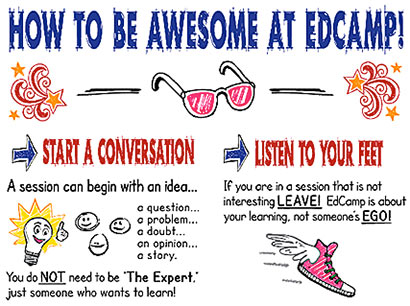
Speaking of evolving, Yelena and I just got back from an EdCamp today. We woke up bright and early drive two hours south to Wellsville, NY to experience our first unconference. If you haven’t been to an EdCamp, you should definitely check it out. It’s essentially a day where teachers bring their PD interests and expertise and the schedule and sessions for the day are designed on the spot from teacher input. Sessions aren’t led so much as facilitated and they are intended to be collaborative discussions with teachers learning from each other. Even though my intent was just to sit back and listen, Yelena and ended up facilitating two of the sessions: one on digital Breakout Edu (we attended the morning session that introduced traditional breakouts) and a session on Google Classroom. We will probably try to organize our own EdCamp in the Rochester area, but that’s for the future…
So here I am at 10:20 sifting through my goody bag (mostly books I won through the EdCamp raffle-Yelena snagged a subscription to PearDeck which we’ve both been itching to play around with) exploring some of the sponsor paraphenalia. And of course I’m drawn to the stickers because I’ve always been a sticker person. One of the stickers floating around in my bag is for an app/website called Boomwriter. From what I can tell, Boomwrite has been around for a minute- the youtube tutorials are several years old (and none are up-to-date) and it touts itself as “The Best Group Writing Tool” (evidence-based claim for the ELA teachers?). Irrespective of whether it’s new or old, good or bad, it’s new to me and I’m digging into it to see if it has potential for myself or for my colleagues.
Frustrations aside from some of the limitations with playing with the app (in order to play around with the StoryWriter tool, you must have 5 students enrolled in the class which means I would need to make at least 3 more dummy gmail accounts for myself!), the gist of the app is that you provide writing prompts to students. You can provide detailed guidelines for their task and there is a feature to build in a word bank for them to incorporate into their writing. After students respond to the prompt, the teacher gives feedback, students revise, and then, student work is disseminated to the class for peer review. The process is chunked and it is anonymous but this is- in my mind- the powerful transformative component of BoomWrite that pushes it up the SAMR model from the SA level to the MR level.
On a side note, their videos/advertisements are on point- useless for learning the app but absolutely making me lol.
I think the original intent of the app was for students to collaboratively write chapter books (and it sounds like prompts and first chapters were already provided). Students all wrote submissions for the subsequent chapters and after the anonymous peer review, the winner became the official chapter for the book. So it’s definitely neat as a group publication app. It has since expanded to offer some vocabulary activities for students as well as the ability to have students write their own textbooks collaboratively in groups.
As I look at a new app, I’m always considering a few core questions (after I get past either the “cool factor” or the “frustration factor”). These questions include:
- Is there an app that I use that already offers this function? Does this app do it better?
- How could I use this app in my classroom?
- Is this the best way to get the outcome I’m looking for?
When I consider the review process that this app facilitates, it’s a process that really can be done on paper using protocols without any tech and it can be done through google docs and forms. Both of those approaches probably require a little more prep and material development on the part of the teacher, and the google doc method might require some workarounds that are fairly multi-step. So I can see how BoomWrite helps to Augment this task. I also think that it’s ability to collate and publish a full books definitely shifts the final product to a new level that may begin to hover around the Modification realm. There is something about the tightness and organization of the app (and almost the game element of trying to “win” a being the best chapter/section) that appeals to me and I think it would appeal to students. I would definitely recommend this to my ELA colleagues and anyone interested in forming a student writing group.
SAMR and “cool factor” aside, I’m a science teacher and I need to bring my mind back to the TPACK model to see if this piece of technology is the best way to teach and assess science concepts through solid pedagogy (I should note that the free version of the app gives you the ability to create assignments and engage in peer feedback. The version you pay for provides more data monitoring tools. While I’m not convinced that it’s the most robust platform for data monitoring, at $2.99/month, the price is not bad. For me, however, free is sufficient).
I’m really interested in this app as a tool to facilitate the creation of final products by my students. I would particularly love to have my self-contained students develop a class-wide review book that we have written, critiqued, revised, and compiled together. Not only does that give me an idea of each students’ personal understandings and take-aways from units, but it lets us engage in a rigorous process of determining what is the important info, how much is too much, what info is useless, and we’re doing all of this through writing and dialog targeting the critical social and communication skills that many of them are lacking. Since the product is for their (and perhaps other students’) use at the end of the school year, they have an investment in creating a quality product. This could become a really useful sponge activity to use all year long.
Then (and I admit this might be less “content-y” but it’s kinda fun), I wondered if there would be any benefit in creating sci-fi story starters with word banks of current science vocabulary (or just important concepts) and providing students with writing challenges as enrichment assignments or a final product that they can choose. I’d love to bring creative writing into the science classroom. Not as a central focus, but it could be a powerful hook for kids who are movie-lovers and sci-fi nerds who haven’t yet realized that the principles of high quality science fiction have high quality science as their foundation.
These are just the two immediate uses I thought of for high school science classroom. I’m hoping more come to me or that I hear other people’s ideas because I truly believe that I need to get my students to write more- but if all of that writing is boring same old, it’s not going to work.
Clearly, my tech choices don’t always align perfectly with the SAMR or TPACK models- sometimes it is just about the novelty factor or the fun factor. But using those lenses helps me understand why I make the choices I do. And then when I have to sit for a pre- or post conference with my admin, I can justify how I met the 5000 expected teacher competencies (I’m telling you, these videos are slaying me).
***Hurray for me! Two posts in one day. The previous post was much delayed in getting published.
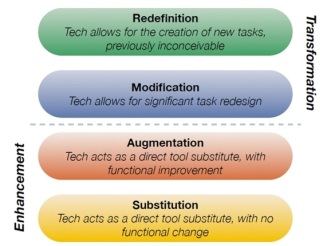
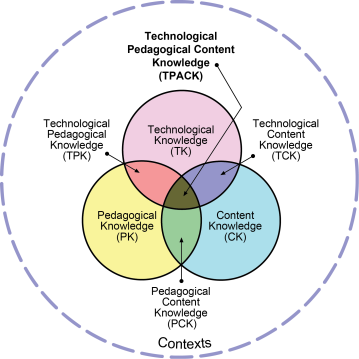
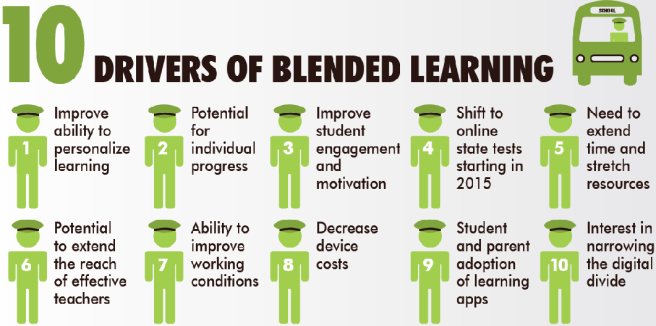
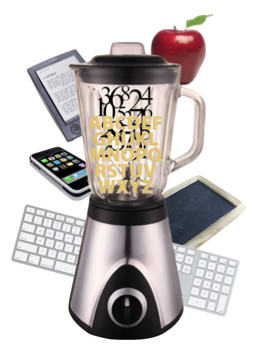 Two summers ago, our school was approached with an intriguing proposition: Would we be interested in implementing a blended learning model in our classrooms? Our district had recently purchased curricula for several blended learning courses and they were seeking brave souls to adventure into the unknown of online learning.
Two summers ago, our school was approached with an intriguing proposition: Would we be interested in implementing a blended learning model in our classrooms? Our district had recently purchased curricula for several blended learning courses and they were seeking brave souls to adventure into the unknown of online learning.